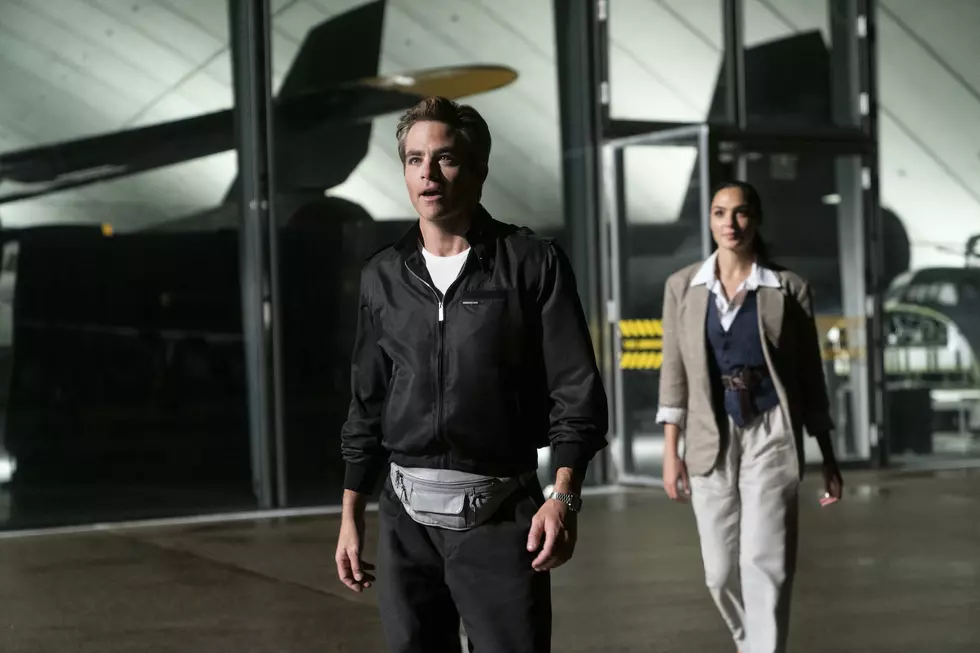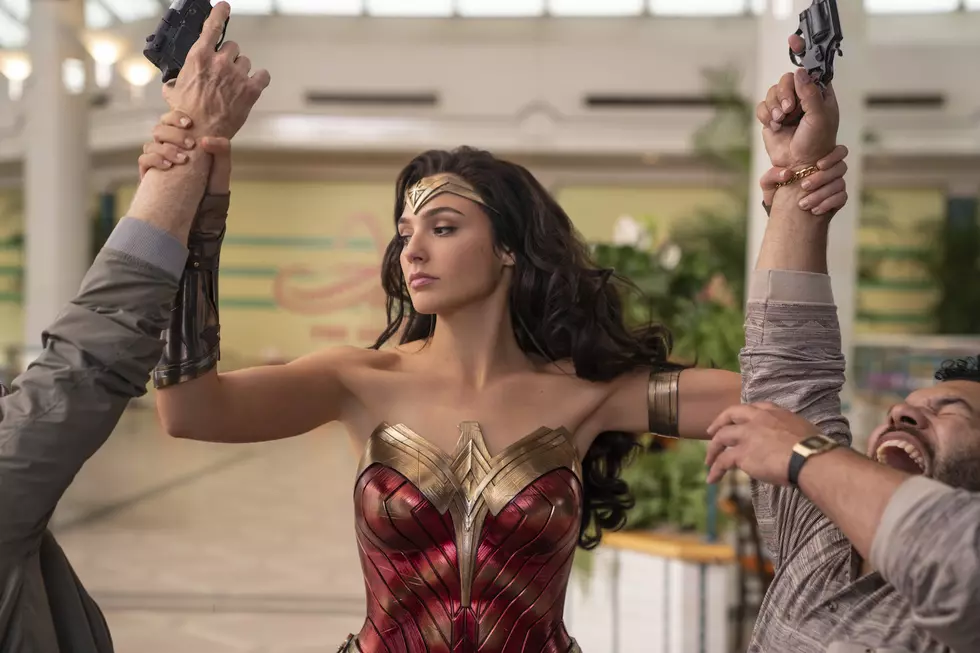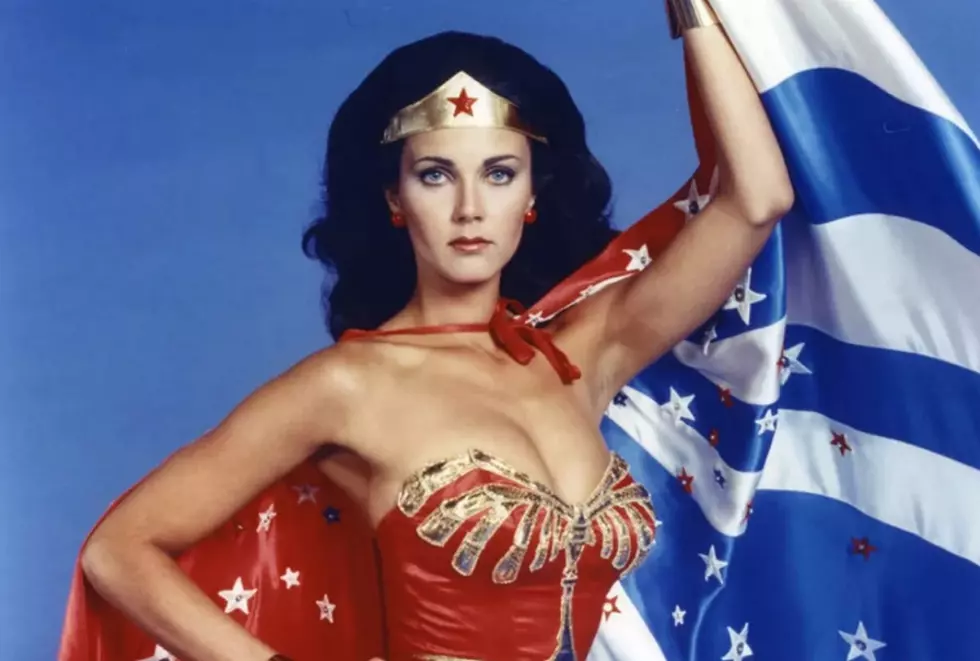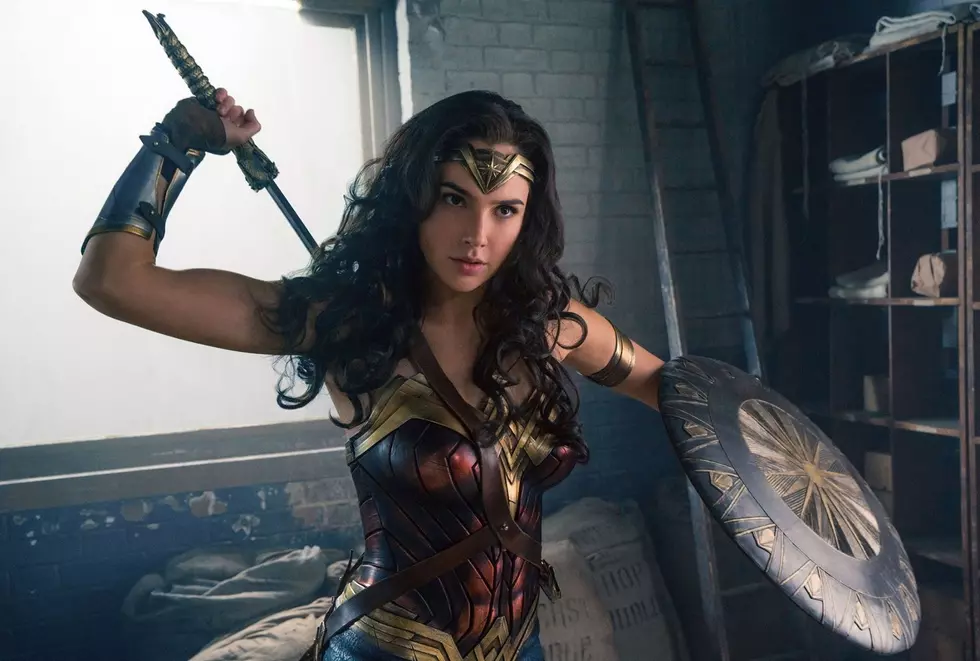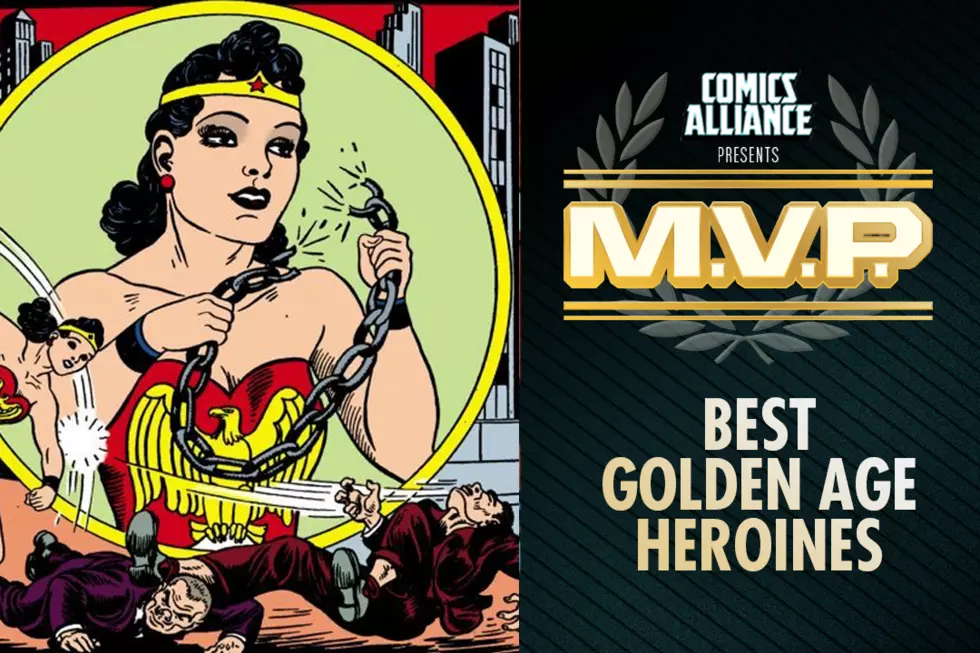![You Go For Broke On Apokalips: Corinna Bechko & Gabriel Hardman Talk ‘Sensation Comics’ [Interview]](http://townsquare.media/site/622/files/2014/11/WW00.jpg?w=980&q=75)
You Go For Broke On Apokalips: Corinna Bechko & Gabriel Hardman Talk ‘Sensation Comics’ [Interview]
Over the past few years, Gabriel Hardman and Corinna Bechko have quickly become one of the creative teams that I look forward to seeing the most, and this week, they're giving me a pretty good reason to be excited. Today marks the release of the first installment of their three-part story in Sensation Comics, the digital-first Wonder Woman anthology, which finds DC's Amazon Princess sent on a rescue mission to Apokolips, the home of the evil New Gods.
To find out more, I spoke with Bechko and Hardman about their approach to Wonder Woman, their take on Jack Kirby's cosmic evil, and just why it is that page turns are so magical.
ComicsAlliance: The only thing I really knew about this story going into it is that it's Wonder Woman on Apokolips.
Gabriel Hardman: That is correct. It's a thirty-page story, so digitally it's a three-part series in Sensation Comics, and it's a little bit of an espionage story where Wonder Woman's mother sends her to Apokolips to try to bring back two missing Amazons who have gone there to spy on Darkseid. When she gets there, things turn out to be a little different than she expected.
CA: That's really interesting, because we don't usually see Wonder Woman in an espionage story. She has the secret agent stuff in her background, but we rarely see her in a spy-themed adventure. Usually it's just more straight-up superheroics.
GH: Right. I think part of it is that Themyscira, from our point of view in approaching a story like this, is sort of a nation-state. Wonder Woman would be the most powerful representative of this nation-state, and so you can imagine a scenario where her mother would turn to her in a difficult circumstance like this. The thing with this, though, is that when we talk about it as espionage, it's... well, it's not hardcore stuff. It's still dealing with broad strokes like Apokolips and the Fourth World, but we're playing it pretty straight. We want there to be stakes. We're not winking at the audience, we want it to be earnest.
Corinna Bechko: Even though there are giant dogs.
GH: Yes, there are people riding giant dogs in it. Take from that what you will.\
CA: Of course there are! It's Apokolips! But since you mentioned the broad strokes, what does that kind of spy story look like in a setting like Apokolips? When it's on a giant evil planet with fire pits and statues of Darkseid everywhere?
CB: We have all of those things! Multiple fire pits.
GH: As far as the visual aspect of it, I obviously went in it thinking "Great, this is doing a Jack Kirby Fourth World thing!" But then it didn't really come naturally to me, to have the designs be as broad as he would do it. Somebody like Steve Rude can so perfectly synthesize that feel into his own style, yet I don't know that I could. I think my Apokolips is a little bit more like Moebius meets Blade Runner, you know? It has the feel of the Jack Kirby stuff, of course, because why else would you do it, but I also felt like I had to ground it a lot more to make it work for me. I always have to feel like it's coming from a place where it's understandable and relatable. I can't do big, broad stuff where it feels like it's cartoony, so I had to find my own way into it, and I think it's darker. It's probably a little darker and, for lack of a better term, grittier than you'd normally see Apokolips. And with a lot more pipes. A lot more steam.
CB: Similarly, from a story perspective, we figured that just because the government is evil, that doesn't mean that the populace is evil. So it takes place on the ground level, people living underground, the common folk. They can't choose what government they live under.
GH: There's a lot about the Lowlies, and seeing this totalitarian state from their perspective.
CA: That's an interesting way to do it. The thing that I'm always drawn to with Kirby is that lack of subtlety, that the guy who represents the dark side of humanity is literally named "Darkseid."
GH: Absolutely! Totally. And we're walking a thin line here, but the fact is, we just gotta play to what works for us. But it's not like this is some meditative John LeCarré story. It's a later John LeCarré story. It's an action story in a lot of ways, it moves real fast, and it's not amazingly subtle. There's still a big fight scene with the Female Furies. I know exactly what you're talking about, about the appeal of the absolute ridiculousness of the Kirby stuff in a lot of ways, I have all the omnibuses and I love them.
CB: It's the giant dogs.
GH: It's the giant dogs. But I feel like it would be fake and phony to approach it and try to do what he did. I don't want to do that at all. I don't want to emulate other people's stuff. You want to find something to say that they didn't say.
CA: I think that's what Kirby would've wanted, too.
GH: He wanted to make stuff up every panel! He wanted to be making stuff up all the time!
CA: You bring up the idea that it's a story that moves fast, and I'd think it would have to. Wonder Woman tracking down missing Amazons on Apokolips is a story that doesn't seem like it would lend itself to quiet reflection.
CB: True.
CA: At the same time, you have thirty pages to work with, broken into three issues. What was that challenge like, to get everything you wanted to do into the story? Was it part of the fun?
CB: Part of the challenge is that, since it's a thirty-page story and three ten-page stories, you have to bring it to a satisfying arc every ten pages. That's a challenge, but it's fun to ramp it up and have those cliffhangers that often.
GH: That's the challenge of it, but the fact that you're creating this for multiple formats is also a big part of it.
CB: That's true.
GH: In the art, each standard comic page is broken in half, so there's basically a mini-arc or mini-climax twice a page, halfway through the page, every time.
CB: Which means you get a lot of page turns, and a lot of reveals.
GH: In that way, it totally lends itself to being a faster paced story where a lot of things happen. We'll see how it reads in the print version. On some level, I feel like you have to make it for the digital version and the print version at the same time, and I took great pains in the art. I did a Batman story that Jeff Parker wrote for the digital Legends of the Dark Knight a few years ago, so I'd gotten a taste of this format, where you're designing everything for the whole page and for the half-page. I think the challenge of that is the appeal of it, and it lends itself to stories that move quickly. I want you to never think about the fact that these pages would've been broken in half if you're reading the print version, that they basically have to have a line down the center of every page. In every format, it should feel like its the native format. But that challenge is good, that's part of the reason to do something like this.
CA: Corinna, you mentioned page turns and getting twice as many in digital. I'm not sure if readers are aware of it because it's almost something that has to be pointed out to you, and then you can't stop noticing it, but page turns are kind of where the magic happens in comics.
CB: That's true. It's something I didn't think about at all until I started writing comics. It never really occurred to me to think about it until I started really trying to figure it out, like "Oh, this is how you move the action forward and keep a surprise."
GH: But readers shouldn't know that stuff.
CB: That's true.
GH: They should just be able to enjoy it in a straightforward way, and not understand how they're being manipulated by us at every turn.
CB: I guess if they're thinking about being manipulated, that's probably a bad sign.
GH: Yeah, you're losing them. Then they're just sitting around contemplating the format or something instead of being taken in by the story.
CA: That's, uh, basically my job, guys.
GH: Chris, what's going on?! Why are you letting us down?!
CA: But having to break that down, doing two on a page, does that add a level of complexity, or does it feel like you have more space to work with?
CB: Yes.
GH: Yes, absolutely. It weirdly does, that's why we were saying we'll see how it reads as a printed comic. Normally, we'd let something breathe more than we are, but that said, if you're not going to try different things, why do it? If there's a little more stuff packed in, maybe I don't get quite as many pensive downbeats where people stare into space.
CB: There's a few.
CA: On the subject of doing new things, Wonder Woman and the Fourth World have never really gone together until recently, when Brian Azzarello and Cliff Chiang made it a big part of their run on Wonder Woman. Was your story informed by that at all, or was it more that they were all parts of this bigger DC Universe mythology?
GH: We always wanted to do a story on Apokolips, and we thought "Hey, here's this Wonder Woman thing where we can go any place, maybe we should take her to Apokolips?" I think it was pretty straightforward. One of the good things about Sensation Comics is that it takes place outside of continuity and gives us the freedom to be telling our own story rather than just being locked into whatever's going on at the moment. I wouldn't want to do something that stepped on the story they were doing, and I wouldn't want people to be thinking about their story more than our story.
CB: Honestly, another reason we decided on sending her there was that, historically, preparing for this, I read a ton of Wonder Woman from different eras, from the very first stuff all the way to today. The modern stuff aside, it often seems like she just goes up against a lot of things that don't seem to be her equal. You want to put her someplace where she has to scrape and use all her strength, and can really pound things without worrying about it. You can really go for broke on Apokolips in a way that you couldn't in the Midwest. We wanted to showcase what she can do without reining her in.
CA: Sensation Comics exists with the same sort of idealized version of Wonder Woman that we got for Superman and Batman in Adventures of Superman and Legends of the Dark Knight, but was there a particular version that informed your take more than any other?
CB: This sounds terrible, but we kind of just picked and chose what we liked about different eras, as far as her personality goes.
GH: The main time that I read Wonder Woman was when I was a kid and the George Perez book was going, so in the broadest sense, that and the television show are what I think of, but we weren't thinking about the television show. We did go back and read stories from every era to try and get a grasp on her rather than just relying on memories, and while I don't think this is what people who just love continuity are going to want to hear, it was definitely the case that we were trying to make a Wonder Woman that utilized the aspects of her that we like.
CA: Was it difficult to boil her down to the essentials?
GH: Yeah.
CB: Yes, because it seems like she's been all over the map. Some other characters have remained iconic and the same, but it seems like a lot of people have very different takes on Wonder Woman. But in a way, that's a good thing, because I felt like we could have her as we envisioned her and still be true to the character.
GH: That's another answer to the "Why Wonder Woman on Apokolips?" question. Especially in retrospect, it frequently feels like it's all about supporting characters talking about how awesome she is all the time, rather than defining her character through action. And when I say "action," I don't just mean people punching each other, necessarily, but what the characters do. I think we're usually pretty high on the idea of telling you who these characters are through what they do and how they react to things rather than how other people react to them, or some sort of narration that explains stuff to you. We're not fond of explaining.
CB: We don't usually do voiceover.
GH: We almost never do voiceover, because that's just explaining to the audience or the reader what we want them to think about it. For me, I really feel like it's important to tell the story through the action and let the reader decide what they should think about it. Taking her to Apokolips means that we get to see her interact and react to things that are outside of the normal sphere of what she would deal in. That's the character-defining stuff of it, not people standing around saying "Oh, she's the tallest, prettiest-smelling Amazon."
CA: Those are usually the two things that come up: Height and odor. Without spoiling anything, is there any particular scene that you did that is like "This is it, this is Wonder Woman for us."
CB: When we first started working on the project, we went back and forth a whole lot about what she was like and how she'd react to certain situations, and we kind of went through a lot of different variations until we settled on how she's react, and just carried that through to how she'd react to everything.
GH: Also, one of the things about it is that early on, she fails. She has a bit of hubris going on going into this situation, and she fails and has to claw her way back up from there. I don't really feel like you're telling a heroic story unless you've defined the conflict and the odds against them succeeding, and that just goes back to our feeling that a perfect, idealized character just isn't something we can write.
CB: That can be a problem with her, because she's so powerful and so good. She's supposed to be such a good person, she doesn't have a lot of flaws.
GH: Obviously, people have written her in certain ways, like the Rucka run, where she does things people don't approve of, and she's been dealt with in that way. She's been dealt with in every kind of way.
CB: Absolutely.
GH: But in our story, we wanted to make sure that she was a person who could fail, and not necessarily a person who's going to get everything right all the time.
Hardman and Bechko's Wonder Woman story starts in Sensation Comics #16, available on Comixology.
More From ComicsAlliance

